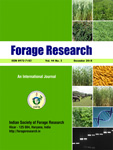ANITA KUMARI*, K. S. AHLAWAT, DALIP KUMAR BISHNOI, KAUTILYA CHAUDHARY, CHHAVI SIROHI, VIRENDER DALAL AND PAWAN KUMAR POONIA
Department of Botany and Plant Physiology, Department of Forestry, Department of Agricultural Economics, Department of Soil Science
CCS Haryana Agricultural University Hisar-125 004 (Haryana) India
*(e-mail: anitahsr@gmail.com)
(Received: 22 August 2024; Accepted: 28 September 2024)
SUMMARY
The present work was conducted to study the effect of willow (Salix alba) based agroforestry system (AFS) on physiological and yield responses of different crops. Sorghum (Sorghum bicolor), wheat (Triticum aestivum), barley (Hordeum vulgare) and mustard (Brassica juncea) were sown in their respective seasons with willow intercropping (5-year old willow based agroforestry system with a spacing of 3m×3m) and without willow intercropping i.e. as sole crop in open fields. Willow growth parameters, including basal diameter (14.35 cm) and DBH (12.19 cm) were recorded during the study. Observations were recorded on growth, physiological traits, yield attributes and economics of the intercropped species compared to their respective sole crop under willow based AFS. A significant reduction in photosynthetic rate, plant height and yield parameters was observed in all the above crops with willow-based AFS compared to open-field sole cropping system. Fodder yield in sorghum ranged from 5.41 t/ha (with willow) to 40.90 t/ha (sole crop control) whereas grain yield of wheat and barley ranged from 1.76 t/ha (with willow) and 4.33 t/ha (open field), and 0.74 t/ha (with willow) and 3.91 t/ha (open field) respectively. However, mustard seed yield ranged 0.99 t/ha (with willow) to 1.88 t/ha (sole crop).
Key words: Agroforestry, barley, grain yield, green fodder, sorghum, mustard, wheat, willow

